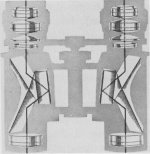-
Welcome to BirdForum, the internet's largest birding community with thousands of members from all over the world. The forums are dedicated to wild birds, birding, binoculars and equipment and all that goes with it.
Please register for an account to take part in the discussions in the forum, post your pictures in the gallery and more.
You are using an out of date browser. It may not display this or other websites correctly.
You should upgrade or use an alternative browser.
You should upgrade or use an alternative browser.
19/11/2012 New LEICA GEOVID (1 Viewer)
- Thread starter binomania
- Start date
More options
Who Replied?brocknroller
porromaniac

Thanks to hunters for checking us brownish green suited birders out not through their rifle scopes!
"I think the larger question is whether or not Leica sees fit to offer a binocular only version of this new porro."
I agree and I bet and hope not. The patent puts up the new prism mainly for its convenience at deflecting information into and out of the beam path, not as an improvement in optical quality or cost savings. The Ultravids are so elegant and minimal, many fans point to this as a strong appeal of the brand, and it would be silly to give that up for a few mm of "plasticity" and a copycat open bridge look. Leica cuts a mighty mean roof angle in my experience.
Not that the Ultravid couldn't stand a shot in the arm, considering the activity of the other brands of late. But please, not banana-ization!
Ron
Not me, I'd like to see all counties involved in making bins including the Banana Republic license the Perger design and ring in a new era of the bananization of all closed bridge roofs! It's the only way they can make an open bridge roof w/out fear of being sued by Swarovski. I'd also like to see this design offered in yellow.
Then maybe I'd be interested in buying something other than the 8x32 EL, which remains the sole roof to fit my hands well.
<B>
Not me, I'd like to see all counties involved in making bins including the Banana Republic license the Perger design and ring in a new era of the bananization of all closed bridge roofs! It's the only way they can make an open bridge roof w/out fear of being sued by Swarovski. I'd also like to see this design offered in yellow.
Then maybe I'd be interested in buying something other than the 8x32 EL, which remains the sole roof to fit my hands well.
<B>
Yes! Let's have no bananas!
http://www.youtube.com/watch?v=jT6JkceQ9FU
:-O :-O :-O
Two brief comments.
The field of view for the 8x is only average, but 114m/km is very good for a 10x. The 10x50 Ultravid has 117m, 10x32 Ultravid 118m and 10x42 Ultravid 112m, and of these the 50 & 32 have some of the widest fields among 10x premiums. The 10x42 Nikon SE has 105m/km.
In the cut-out image, the Perger prism assembly actually looks very compact, in fact more compact than the Schmidt-Pechans in the Ultravids.
And a third comment. The underhung form factor is more comfortable to hand-hold while viewing than the normal roof straight-line design. It allows one to hold hands and arms slightly lower, and even a small difference here helps keep the arms from tiring as fast. So, this prism design would be nice to see in non-RF binoculars (and especially in stabilized binoculars) as well.
Kimmo
The field of view for the 8x is only average, but 114m/km is very good for a 10x. The 10x50 Ultravid has 117m, 10x32 Ultravid 118m and 10x42 Ultravid 112m, and of these the 50 & 32 have some of the widest fields among 10x premiums. The 10x42 Nikon SE has 105m/km.
In the cut-out image, the Perger prism assembly actually looks very compact, in fact more compact than the Schmidt-Pechans in the Ultravids.
And a third comment. The underhung form factor is more comfortable to hand-hold while viewing than the normal roof straight-line design. It allows one to hold hands and arms slightly lower, and even a small difference here helps keep the arms from tiring as fast. So, this prism design would be nice to see in non-RF binoculars (and especially in stabilized binoculars) as well.
Kimmo
Yes! Let's have no bananas!
Surely a few should be allowed:
http://www.youtube.com/watch?v=3BI9UoJvjKA
Or for planetary observers:
http://www.youtube.com/watch?v=JH3WvI_S6-k
Renze de Vries
Well-known member
Now Leica, keep on with that spirit of innovation and give us birders, instead of the range finder, image stabilisation in a not bulky package. Also, porro II prisms should allow even wider fields of view.
Steve,
Could you elaborate some more on the subject of porro II prisms allowing wider field of view please?
After the innovations undertaken by Swarovski, Zeiss and Nikon it seems to me that increasing the FoV is THE issue left for Leica in binocular design. And very welcome, I'd say.
Renze
Holger Merlitz
Well-known member
Steve,
Could you elaborate some more on the subject of porro II prisms allowing wider field of view please?
After the innovations undertaken by Swarovski, Zeiss and Nikon it seems to me that increasing the FoV is THE issue left for Leica in binocular design. And very welcome, I'd say.
Renze
Maybe I could comment on that: With very wide angles, the Porro I is increasing in size and at the same time also the beam-offset turns larger. This requires a bulky body and a corresponding high weight. With the Porro II, the beam offset is smaller (it equals the prism entrance diameter, while with the Porro I, the offset equals 1.41 times the prism entrance diameter). Hence, the Porro II wideangle would be somewhat less heavy. Compare the both Zeiss (blc) 8x60 submarine-commander glasses, where the Porro II was visibly slimmer and lighter than the Porro I.
Perger has mentioned in his patent that his new prisms may deliver a higher amount of vignetting than the Porro - so I guess they are not the first choice for super-wide angle binoculars. But they are a first choice for high performance binoculars with average field of view, having no roof edge and no reflective coating, and being cemented to reduce light loss.
Cheers,
Holger
Omid
Well-known member

Thanks, Pier! An alpha porro!!! I never thought I'd live to see the day, too bad it's a rangefinder, I would love to see this hybrid design in a birding bin, but NOT for $3,592! Izzat a new world record for the price of a pair of binoculars?
<B>
Yaaaaaaaaay!! A new alpha Porro!!
@ Steve C: I agree with you that (when desired) a rangefinder device must be included in binoculars not in riflescopes. Similarly, zoom functionality must also be incorporated only in binoculars not in rifle scopes. You should be doing no physical or mental calculations or functions that distracts you from focusing on your quarry, no turning knobs, no MOA calculations, no wind speed measurement.
Do you know if Leica is attending SCI show? I might go and would like to see these binoculars.
Last edited:
Renze de Vries
Well-known member
Regarding wide field, according to the Leica web site, the original Leitz Trinovid 7x42 and 8x40 from 1958 had 70 and 80 degree apparent fields. I don't know how much they weighed, or even how they performed. They were of course pre-phase correction coating.
Leif,
Those 1st generation Trinovids from 1958 had 170/1000m or 9.7 deg. RFoV (7x42) and 175/1000m or 10 deg. RFov (8x40) which equates indeed to round about 70 and 80 deg. AFoV.
These binoculars contained a two-part mirror plus a roof prism per side. Of course they were not phase coated (and not yet multi coated as well). I own the 8x40 and while resolution, brightness and contrast leaves much to be desired in comparison to contemporary A mark models, experiencing the wide, relaxing field of view is really something else.
I weighed the 8x40 and it brought 850 grams on the scale.
Renze
PS. see Holger Merlitz thoughts on today's narrow angle binoculars (and the promotion of sharp edges) here http://www.holgermerlitz.de/wide/wideangle.html
Leif,
Those 1st generation Trinovids from 1958 had 170/1000m or 9.7 deg. RFoV (7x42) and 175/1000m or 10 deg. RFov (8x40) which equates indeed to round about 70 and 80 deg. AFoV.
These binoculars contained a two-part mirror plus a roof prism per side. Of course they were not phase coated (and not yet multi coated as well). I own the 8x40 and while resolution, brightness and contrast leaves much to be desired in comparison to contemporary A mark models, experiencing the wide, relaxing field of view is really something else.
I weighed the 8x40 and it brought 850 grams on the scale.
Renze
PS. see Holger Merlitz thoughts on today's narrow angle binoculars (and the promotion of sharp edges) here http://www.holgermerlitz.de/wide/wideangle.html
Thank you Renze for the informative post. I had heard that some binoculars employed mirrors as well as prisms. Think what they binocular might be like with modern coatings, and a magnesium frame. With modern dielectric coatings, the mirrors could be almost perfect, and lighter than prisms alone. Do you (or anyone else) have a cutaway diagram of those binoculars?
As far as I can see all roof prisms are conceptually the same i.e. a roof that erects/inverts the image, and a contraption of reflections before and after to ensure the input and output beams are inline +/- a small offset. So a conventional erecting roof prism could be replaced with a smaller lighter Amici roof prism, and two mirrors, one in front and one behind, each deflecting the beam by 45 degrees, thereby saving weight. Collimation might be a pig. Perhaps that is what Leitz did.
Do you know why the original Trinovids cost so much? According to Leica, high cost was the reason for their discontinuation.
jan van daalen
Well-known member
Last time I was at Leica Customer Service we talked about this subject and they told me that building this bin costed 18 hours and repairing it almost the same. So yes, high costs as a reason looks reasonable to me.
This is one of the reasons Customer Service is more and more involved in design matters.
Jan
This is one of the reasons Customer Service is more and more involved in design matters.
Jan
Leif,
Those 1st generation Trinovids from 1958 had 170/1000m or 9.7 deg. RFoV (7x42) and 175/1000m or 10 deg. RFov (8x40) which equates indeed to round about 70 and 80 deg. AFoV.
These binoculars contained a two-part mirror plus a roof prism per side. Of course they were not phase coated (and not yet multi coated as well). I own the 8x40 and while resolution, brightness and contrast leaves much to be desired in comparison to contemporary A mark models, experiencing the wide, relaxing field of view is really something else.
I weighed the 8x40 and it brought 850 grams on the scale.
Renze
PS. see Holger Merlitz thoughts on today's narrow angle binoculars (and the promotion of sharp edges) here http://www.holgermerlitz.de/wide/wideangle.html
Here is a Leica History. Regarding the Leitz Trinovids it shows the years they were made for each model and their FOV's (in yards) are shown and their weights are shown (some in grams, others in ounces.)
http://home.europa.com/~telscope/leitzbin.txt
It shows the FOV of the 7 x 42's as 140 yards (420') @ 1000 yards. Armored (7 x 42BA) versions are 660 grams. They were made from 1981 to 1990. 7 x 42B versions were made from 1968-1986 and weighed 23 ounces.
Bob
That history misses out the 1958 Trinovids. Here is the link I used:
http://test.www.l-camera-forum.com/leica-wiki.en/index.php/Roof-Prism_Leica_Binoculars
I wonder why they cost so much to make and service? Was it just collimation?
http://test.www.l-camera-forum.com/leica-wiki.en/index.php/Roof-Prism_Leica_Binoculars
I wonder why they cost so much to make and service? Was it just collimation?
normjackson
Well-known member
Daring to venture a bit further off topic, Renze you wouldn't happen to "be in the know" about what became of Fan Tao and his site would you (I see Holger has a couple of lost links there now)?PS. see Holger Merlitz thoughts on today's narrow angle binoculars (and the promotion of sharp edges) here http://www.holgermerlitz.de/wide/wideangle.html
Just found I still have the pdf to accompany his 2004 talk overviewing the history of wide angle binoculars. German, US and French products get a mention. And, hooray, a British product. Nope, sorry, not a Taylor Hobson but the Ross Stepnada 7x30.
Incidentally BFer LPT on his photostream says he found the later Trinovid 7x42B model a cinch to service.
Renze de Vries
Well-known member
Here are some pictures of the 1st generation Leitz Trinovid 8x40. The 7x42 looks the same, be it that the eyecups are longer. The Leitz trademark - in script - and the Trinovid marking are usually found on the ocular beauty rings but I've seen specimen where it's on the lower bridge front. It's an exceptionally well made instrument and this goes for the case too, which is a work of art I've never seen before or since.
For the diagram I'll give you the complete patent application. Note that the patent is for the focusing mechanism and not for the optical construction. Possibly the patent for the optics was already filed for the Amplivid.
If this is correct (optical construction identical to the Amplivid) the question comes up why exactly the Trinovids were so much more difficult to make and service. I seem to remember someone saying that positioning of the mirror was exceptionally critical, and so labor expensive, to the point where production of this 1st generation Trinovid had to be stopped and only a few hundred of them were made. Note that this seemed to be not the case, or less seriously so, for the Amplivid.
I'll also enclose a diagram of the Amplivid, as found in an earlier discussion on the use of mirrors in wide angle binoculars: http://www.birdforum.net/showthread.php?p=1761380
About Fan Tao, yes in his last update when the website was still on the air, he described a recently acquired 1st generation Trinovid 7x42. Unfortunately the site is still dead, and partial recovery doesn't contain the last update.
Renze
For the diagram I'll give you the complete patent application. Note that the patent is for the focusing mechanism and not for the optical construction. Possibly the patent for the optics was already filed for the Amplivid.
If this is correct (optical construction identical to the Amplivid) the question comes up why exactly the Trinovids were so much more difficult to make and service. I seem to remember someone saying that positioning of the mirror was exceptionally critical, and so labor expensive, to the point where production of this 1st generation Trinovid had to be stopped and only a few hundred of them were made. Note that this seemed to be not the case, or less seriously so, for the Amplivid.
I'll also enclose a diagram of the Amplivid, as found in an earlier discussion on the use of mirrors in wide angle binoculars: http://www.birdforum.net/showthread.php?p=1761380
About Fan Tao, yes in his last update when the website was still on the air, he described a recently acquired 1st generation Trinovid 7x42. Unfortunately the site is still dead, and partial recovery doesn't contain the last update.
Renze
Attachments
-
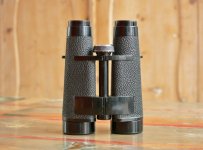 Leitz Trinovid 8x40 front(800x594).jpg288.2 KB · Views: 365
Leitz Trinovid 8x40 front(800x594).jpg288.2 KB · Views: 365 -
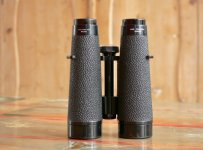 Leitz Trinovid 8x40 back (800x594).jpg291.1 KB · Views: 361
Leitz Trinovid 8x40 back (800x594).jpg291.1 KB · Views: 361 -
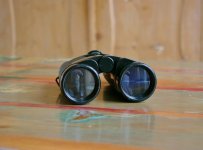 Leitz Trinovid 8x40 obj (800x592).jpg245.4 KB · Views: 263
Leitz Trinovid 8x40 obj (800x592).jpg245.4 KB · Views: 263 -
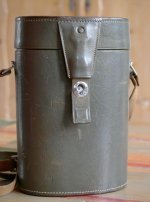 Leitz trinovid 8x40 case (2) (596x800).jpg296.3 KB · Views: 170
Leitz trinovid 8x40 case (2) (596x800).jpg296.3 KB · Views: 170 -
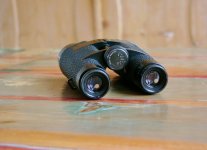 Leitz Trinovid 8x40 ocul (800x581).jpg254 KB · Views: 234
Leitz Trinovid 8x40 ocul (800x581).jpg254 KB · Views: 234
Renze de Vries
Well-known member
Thank you Renze, marvelous information. It is as I thought, a roof prism situated between two large mirrors. Nice pictures. |=)|
I had a look at the link you gave, and Kevin Purcell summed up the likely reasons for mirrors being out of favour, and as mentioned later on, aluminium and silver coatings tarnish with age, thereby reducing the reflectivity. The astronomers here would know more about that than me. With a sealed unit I imagine that is not an issue, and dielectrics are probably even more stable.
I suppose there is another possible issue, and that is the thermal stability of prisms versus mirrors, given that they might be required to operate between -10C and 30C, a range of 40 degrees Celcius.
Interesting that you say that collimation of the mirrors is the likely killer. I wonder if modern technology could do anything about that? I wondered about collimating the system, then using an adhesive to 'fix' the components, but I imagine the adhesive would introduce stresses, and distortions on drying, given the fine tolerances.
You could also use only one mirror on the objective end with the larger prism from the Abbe Koenig pair, and save some weight.
I wonder if displacement of the prisms is an issue in modern bins?
I think as always, the solution that wins is not necessarily the one that gives the best view, but the one that is commercially feasible, and good enough optically, since people think 60 degrees is wide field.
I had a look at the link you gave, and Kevin Purcell summed up the likely reasons for mirrors being out of favour, and as mentioned later on, aluminium and silver coatings tarnish with age, thereby reducing the reflectivity. The astronomers here would know more about that than me. With a sealed unit I imagine that is not an issue, and dielectrics are probably even more stable.
I suppose there is another possible issue, and that is the thermal stability of prisms versus mirrors, given that they might be required to operate between -10C and 30C, a range of 40 degrees Celcius.
Interesting that you say that collimation of the mirrors is the likely killer. I wonder if modern technology could do anything about that? I wondered about collimating the system, then using an adhesive to 'fix' the components, but I imagine the adhesive would introduce stresses, and distortions on drying, given the fine tolerances.
You could also use only one mirror on the objective end with the larger prism from the Abbe Koenig pair, and save some weight.
I wonder if displacement of the prisms is an issue in modern bins?
I think as always, the solution that wins is not necessarily the one that gives the best view, but the one that is commercially feasible, and good enough optically, since people think 60 degrees is wide field.
Aluminum mirrors in telescopes are overcoated with possibly silicone dioxide if I remember rightly.
Modern silver mirrors have complex coatings and very high reflectivity, I think 99%.
With professional telescopes they had in situ coating plants for periodic recoating but I don't know if this is still needed.
In mirror lenses coatings can last decades, the Tamron SP mirrors have special coatings with high reflectivity and also I think they claim high surface accuracies.
Modern mirrors in a copy of the early Leitz would be very good, so I imagine the problem is the labour intensive construction and maybe very fine tolerances needed.
I certainly would like a high performance 80 degree binocular.
Modern silver mirrors have complex coatings and very high reflectivity, I think 99%.
With professional telescopes they had in situ coating plants for periodic recoating but I don't know if this is still needed.
In mirror lenses coatings can last decades, the Tamron SP mirrors have special coatings with high reflectivity and also I think they claim high surface accuracies.
Modern mirrors in a copy of the early Leitz would be very good, so I imagine the problem is the labour intensive construction and maybe very fine tolerances needed.
I certainly would like a high performance 80 degree binocular.
Users who are viewing this thread
Total: 2 (members: 0, guests: 2)




